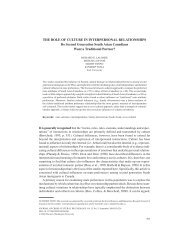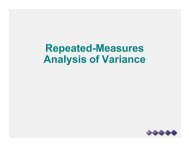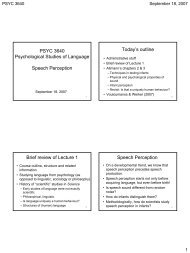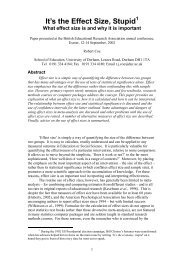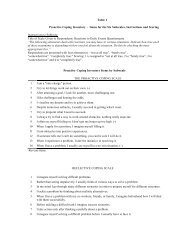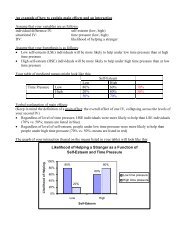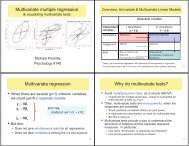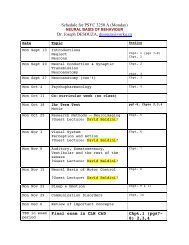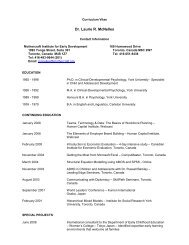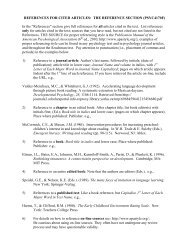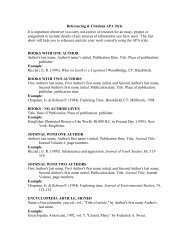A Double-Blind Comparative Study of Clozapine ... - PsychiatryOnline
A Double-Blind Comparative Study of Clozapine ... - PsychiatryOnline
A Double-Blind Comparative Study of Clozapine ... - PsychiatryOnline
You also want an ePaper? Increase the reach of your titles
YUMPU automatically turns print PDFs into web optimized ePapers that Google loves.
Article<br />
A <strong>Double</strong>-<strong>Blind</strong> <strong>Comparative</strong> <strong>Study</strong> <strong>of</strong> <strong>Clozapine</strong><br />
and Risperidone in the Management<br />
<strong>of</strong> Severe Chronic Schizophrenia<br />
Jean-Michel Azorin, M.D.<br />
René Spiegel, Ph.D.<br />
Gary Remington, M.D., Ph.D.<br />
Jean-Marie Vanelle, M.D.<br />
Jean-Jacques Péré, M.D.<br />
Monique Giguere, Ph.D.<br />
Isabelle Bourdeix, Ph.D.<br />
Objective: This prospective, doubleblind,<br />
multicenter, parallel-group study<br />
compared the efficacy and safety <strong>of</strong> therapeutic<br />
doses <strong>of</strong> clozapine and risperidone<br />
in patients with severe chronic schizophrenia<br />
and poor previous treatment response.<br />
Method: Male or female patients aged<br />
18–65 years who met DSM-IV criteria for<br />
schizophrenia and study requirements for<br />
poor previous treatment response (N=<br />
273) were randomly assigned to doubleblind<br />
treatment with either clozapine or<br />
risperidone administered over 12 weeks<br />
in increasing increments. The primary efficacy<br />
measures were the magnitude <strong>of</strong><br />
improvement in Brief Psychiatric Rating<br />
Scale (BPRS) and Clinical Global Impression<br />
(CGI) scores. Adverse events were recorded<br />
throughout the study.<br />
Results: The magnitude <strong>of</strong> improvement<br />
in mean BPRS and CGI scores from baseline<br />
to end <strong>of</strong> the study was significantly<br />
greater in the clozapine group than in the<br />
risperidone group. Statistically significant<br />
differences in favor <strong>of</strong> clozapine were also<br />
seen for most <strong>of</strong> the secondary efficacy<br />
measures (Positive and Negative Syndrome<br />
Scale, Calgary Depression Scale,<br />
Psychotic Depression Scale, and Psychotic<br />
Anxiety Scale). The adverse event pr<strong>of</strong>ile<br />
was similar for both treatment groups,<br />
with a lower risk <strong>of</strong> extrapyramidal symptoms<br />
in the clozapine group.<br />
Conclusions: <strong>Clozapine</strong> showed superior<br />
efficacy over risperidone in this patient<br />
population. Both treatments were equally<br />
well tolerated as demonstrated through<br />
their adverse event pr<strong>of</strong>iles, although as<br />
expected clozapine was associated with a<br />
lower risk <strong>of</strong> extrapyramidal symptoms<br />
than risperidone.<br />
(Am J Psychiatry 2001; 158:1305–1313)<br />
<strong>Clozapine</strong> was the first major advance in the treatment<br />
<strong>of</strong> schizophrenia since the introduction <strong>of</strong> the classic<br />
antipsychotic agents chlorpromazine and haloperidol in<br />
the 1950s (1). Improved efficacy against the positive and<br />
negative symptoms <strong>of</strong> schizophrenia (2–5), a low propensity<br />
to cause extrapyramidal symptoms in both the short<br />
and long term (5–7), together with a lack <strong>of</strong> clinically relevant<br />
effects on serum prolactin (8) distinguished it from<br />
the classic agents and led to the concept <strong>of</strong> the “atypical”<br />
antipsychotic (9). The publication <strong>of</strong> two landmark comparative<br />
trials in the late 1980s unequivocally demonstrated<br />
the efficacy <strong>of</strong> clozapine for patients with treatment-resistant<br />
schizophrenia (2, 10). In their 6-week,<br />
double-blind study <strong>of</strong> 268 patients who met strict criteria<br />
for treatment-resistance, Kane et al. (2) demonstrated that<br />
clozapine was significantly more effective than chlorpromazine<br />
(response rates <strong>of</strong> 30% and 4%, respectively;<br />
p
CLOZAPINE AND RISPERIDONE<br />
TABLE 1. <strong>Clozapine</strong> and Risperidone Titration Schedules<br />
for 273 Patients With Severe Chronic Schizophrenia and<br />
Poor Previous Treatment Response a<br />
Dose (mg/day)<br />
Day<br />
<strong>Clozapine</strong><br />
Risperidone<br />
1 12.5 1<br />
2 25 2<br />
3 50 2<br />
4 75 2<br />
5 100 3<br />
6 150 3<br />
7 200 3<br />
8 250 3<br />
9 and 10 300 4<br />
11–14 b 400 4<br />
15–21 b 500 5<br />
22–28 b 600 6<br />
a Continuous treatment <strong>of</strong> current episode with neuroleptic for at<br />
least 6 months without significant clinical improvement, an unsuccessful<br />
antipsychotic trial <strong>of</strong> at least 6 weeks (equivalent to 20 mg/<br />
day <strong>of</strong> haloperidol) since onset <strong>of</strong> current episode, and no period<br />
<strong>of</strong> good function for at least 2 years despite trials <strong>of</strong> two antipsychotics<br />
from at least two chemical classes (or 5 years despite three<br />
antipsychotic trials).<br />
b Period during which maintenance or reduction <strong>of</strong> dose was permitted<br />
if adverse events were experienced; clozapine or risperidone<br />
dose could not fall below 300 mg/day or 4 mg/day, respectively.<br />
To our knowledge, the present study is the first methodologically<br />
robust study <strong>of</strong> adequate size and duration to<br />
compare the efficacy and safety <strong>of</strong> therapeutic doses <strong>of</strong><br />
clozapine and risperidone in patients with severe chronic<br />
schizophrenia and poor previous treatment response,<br />
which was chosen instead <strong>of</strong> treatment resistance to have<br />
patients more representative <strong>of</strong> those seen in current clinical<br />
practice.<br />
Method<br />
This prospective, double-blind, parallel-group study was conducted<br />
at 41 centers in France (N=29) and Canada (N=12) between<br />
October 1994 and January 1996, in accordance with the<br />
World Health Organization’s Good Clinical Research Practice<br />
Guidelines and the Declaration <strong>of</strong> Helsinki (19). Local ethics committee<br />
approvals were obtained, and subjects gave their written<br />
informed consent after complete description <strong>of</strong> the study.<br />
Patients<br />
Male and female patients aged 18–65 years who met DSM-IV<br />
criteria for schizophrenia (disorganized, catatonic, paranoid, residual,<br />
or undifferentiated) were eligible for recruitment. Only<br />
those with baseline scores <strong>of</strong> at least 4 on the Clinical Global Impression<br />
(CGI) scale (20), at least 45 (total score) on the Brief Psychiatric<br />
Rating Scale (BPRS) (21), and at least 4 on two or more <strong>of</strong><br />
the four core symptoms (unusual thought content, hallucinations,<br />
conceptual disorganization, suspiciousness) were randomly<br />
assigned to treatment with either clozapine or risperidone.<br />
Both inpatients and outpatients were recruited to the study.<br />
Patients were excluded if they had a history <strong>of</strong> medical conditions<br />
or drug treatment that might put them at special risk or bias<br />
the assessment <strong>of</strong> their clinical or mental status (e.g., epilepsy requiring<br />
continuous treatment, active blood dyscrasias, leukopenia,<br />
chronic obstructive lung disease or pulmonary emphysema,<br />
cardiovascular disease or recent myocardial infarction, significantly<br />
impaired renal or hepatic function, active problems with<br />
TABLE 2. Reasons for Premature Discontinuation <strong>of</strong> <strong>Clozapine</strong><br />
or Risperidone Therapy Among 273 Patients With Severe<br />
Chronic Schizophrenia and Poor Previous Treatment<br />
Response a<br />
Patients<br />
Given<br />
<strong>Clozapine</strong><br />
(N=138)<br />
Patients<br />
Given<br />
Risperidone<br />
(N=135)<br />
All<br />
Patients<br />
(N=273)<br />
Reason<br />
N % N % N %<br />
Adverse event 16 11.6 12 8.9 28 10.3<br />
Death b 1 0.7 1 0.7 2 0.7<br />
Consent withdrawn 12 8.7 9 6.7 21 7.7<br />
Protocol violation 2 1.4 2 1.5 4 1.5<br />
Treatment failure c 1 0.7 9 6.7 10 3.7<br />
Lost to follow-up 3 2.2 0 0.0 3 1.1<br />
Other 3 2.2 1 0.7 4 1.5<br />
All 38 27.5 34 25.2 72 26.4<br />
a Continuous treatment <strong>of</strong> current episode with neuroleptic for at<br />
least 6 months without significant clinical improvement, an unsuccessful<br />
antipsychotic trial <strong>of</strong> at least 6 weeks (equivalent to 20 mg/<br />
day <strong>of</strong> haloperidol) since onset <strong>of</strong> current episode, and no period <strong>of</strong><br />
good function for at least 2 years despite trials <strong>of</strong> two antipsychotics<br />
from at least two chemical classes (or 5 years despite three antipsychotic<br />
trials).<br />
b Unrelated to therapy.<br />
c Significant difference between clozapine and risperidone groups<br />
(p
AZORIN, SPIEGEL, REMINGTON, ET AL.<br />
TABLE 3. Demographic and Clinical Characteristics <strong>of</strong> 273 Patients With Severe Chronic Schizophrenia and Poor Treatment<br />
Response a Randomly Assigned to Receive <strong>Clozapine</strong> or Risperidone<br />
Patients Receiving Adequate Doses<br />
Intent-to-Treat Population b<br />
After 28 Days (Per-Protocol Population)<br />
Characteristic<br />
<strong>Clozapine</strong> (N=126) Risperidone (N=130) <strong>Clozapine</strong> (N=93) Risperidone (N=110)<br />
N % N % N % N %<br />
Sex c<br />
Male 97 77.0 85 65.4 73 78.5 72 65.5<br />
Female 29 23.0 45 34.6 20 21.5 38 34.5<br />
DSM-IV diagnosis<br />
Disorganized 21 16.7 25 19.2 18 19.4 23 20.9<br />
Catatonic 2 1.6 2 1.5 1 1.1 2 1.8<br />
Paranoid 73 57.9 67 51.5 53 57.0 57 51.8<br />
Residual 6 4.8 9 6.9 4 4.3 8 7.3<br />
Undifferentiated 24 19.0 27 20.8 17 18.3 20 18.2<br />
Median Median Median Median<br />
History <strong>of</strong> illness<br />
Number <strong>of</strong> previous episodes 6.0 4.0 6.0 4.0<br />
Number <strong>of</strong> hospitalizations 8.0 7.0 8.0 7.0<br />
Time since first episode (years) 13.0 15.5 14.0 15.5<br />
Time since onset <strong>of</strong> current episode (months) 13.0 15.5 15.0 23.0<br />
Time since last episode <strong>of</strong> good function (months) 45.0 62.0 51.0 65.5<br />
Mean SD Mean SD Mean SD Mean SD<br />
Age (years) d 37.8 10.4 39.5 11.3 38.3 10.2 39.5 11.2<br />
Baseline disease characteristics<br />
BPRS total score e 63.7 10.3 61.2 9.9 64.0 9.9 60.8 9.7<br />
Positive and Negative Symptom Scale total score 112.4 17.6 109.3 16.9 112.3 17.6 108.9 16.8<br />
CGI score 5.6 0.8 5.5 0.9 5.7 0.8 5.6 0.9<br />
a Continuous treatment <strong>of</strong> current episode with neuroleptic for at least 6 months without significant clinical improvement, an unsuccessful<br />
antipsychotic trial <strong>of</strong> at least 6 weeks (equivalent to 20 mg/day <strong>of</strong> haloperidol) since onset <strong>of</strong> current episode, and no period <strong>of</strong> good function<br />
for at least 2 years despite trials <strong>of</strong> two antipsychotics from at least two chemical classes (or 5 years despite three antipsychotic trials).<br />
b All patients with at least one BPRS evaluation after treatment initiation.<br />
c Significant between-group differences in gender ratio for both the intent-to-treat population (χ 2 =4.19, df=1, p
CLOZAPINE AND RISPERIDONE<br />
TABLE 4. Baseline Values and Changes From Baseline in Primary Efficacy Measures After 12 Weeks <strong>of</strong> <strong>Clozapine</strong> or Risperidone<br />
Therapy for Patients With Severe Chronic Schizophrenia and Poor Previous Treatment Response a<br />
Baseline Value<br />
Change From Baseline<br />
Efficacy Measure <strong>Clozapine</strong> Risperidone <strong>Clozapine</strong> Risperidone<br />
and Population Mean SD Mean SD Mean SD Mean SD<br />
Analysis<br />
BPRS total ANCOVA F df p<br />
Intent-to-treat b 63.7 10.3 61.2 9.9 –23.2 13.2 –17.7 13.6 13.01 1, 253 0.006<br />
Per-protocol c 64.0 9.9 60.8 9.7 –25.0 12.1 –17.9 12.9 12.31 1, 200 0.0006<br />
CGI total t df p<br />
Intent-to-treat b 5.6 0.8 5.5 0.9 –1.8 1.1 –1.4 1.3 2.68 254 0.008<br />
Per-protocol c 5.7 0.8 5.6 0.9 –2.0 1.1 –1.4 1.2 3.30 201 0.002<br />
a Continuous treatment <strong>of</strong> current episode with neuroleptic for at least 6 months without significant clinical improvement, an unsuccessful<br />
antipsychotic trial <strong>of</strong> at least 6 weeks (equivalent to 20 mg/day <strong>of</strong> haloperidol) since onset <strong>of</strong> current episode, and no period <strong>of</strong> good function<br />
for at least 2 years despite trials <strong>of</strong> two antipsychotics from at least two chemical classes (or 5 years despite three antipsychotic trials).<br />
b All patients with at least one BPRS evaluation after treatment initiation (clozapine, N=126; risperidone, N=130).<br />
c All patients receiving adequate clozapine or risperidone doses after 28 days (clozapine, N=93; risperidone, N=110).<br />
success rates <strong>of</strong> 40% and 20%. Power was reduced to 0.70 when<br />
comparing success rates <strong>of</strong> 35% and 20%.<br />
Three patient populations were defined for the purposes <strong>of</strong><br />
analysis. The safety population comprised all patients who received<br />
at least one dose <strong>of</strong> study medication and had at least one<br />
postdose safety assessment. The intent-to-treat population consisted<br />
<strong>of</strong> all randomly assigned patients with at least one postdose<br />
BPRS evaluation. The per-protocol population comprised all patients<br />
in the intent-to-treat population who completed the first 28<br />
days <strong>of</strong> the study without major protocol violation (i.e., insufficient<br />
documentation <strong>of</strong> poor response to treatment, prior treatment<br />
with either clozapine or risperidone, or inadequate dosing<br />
at day 28). Both intent-to-treat and per-protocol populations<br />
were described in the efficacy analysis, with intent-to-treat being<br />
the population <strong>of</strong> primary interest.<br />
The primary endpoint for efficacy analysis was the end <strong>of</strong> the<br />
third period (i.e., after 12 weeks <strong>of</strong> treatment), obtained by carrying<br />
forward the last observation in the study for each patient. A<br />
secondary endpoint was the end <strong>of</strong> the second period, obtained by<br />
carrying forward the last observation up to the end <strong>of</strong> the titration<br />
schedule (week 4) for each patient. Data were also described at<br />
each visit, from baseline to week 12, based on observed cases at<br />
the visit <strong>of</strong> interest. Descriptive statistics were presented and the<br />
two treatment groups were compared at each <strong>of</strong> these time points;<br />
however, p values at individual visits are purely exploratory.<br />
Randomization was designed to be balanced by country, not by<br />
center, as there were a large number <strong>of</strong> centers that recruited very<br />
few patients, making it difficult to control for a possible center effect.<br />
Control for country effect and its interaction with treatment<br />
were investigated through response rates per the definition <strong>of</strong><br />
Kane et al. (2). A sensitivity analysis was carried out on centers<br />
that had recruited at least six patients and used the same criteria.<br />
Control for language (French versus American English) was not<br />
addressed because 84% <strong>of</strong> patients were French speaking.<br />
Response rates, per the definition <strong>of</strong> Kane et al. (2), were compared<br />
between treatment groups at the end <strong>of</strong> the second and<br />
third periods by using the Cochran-Mantel-Haenszel test, adjusting<br />
for country. The treatment-by-country interaction was tested<br />
by means <strong>of</strong> the Breslow-Day pseudohomogeneity test, based on<br />
the Mantel-Haenszel statistic, for the intent-to-treat population<br />
at the end <strong>of</strong> the third period.<br />
In terms <strong>of</strong> other efficacy measures, improvements from baseline<br />
in quantitative variables (total and subscale scores <strong>of</strong> the Positive<br />
and Negative Syndrome Scale, BPRS core item scores, CGI<br />
score, Calgary Depression Scale, Psychotic Anxiety Scale, and total<br />
and subscale scores <strong>of</strong> the Psychotic Depression Scale) were<br />
analyzed by means <strong>of</strong> t tests. For BPRS total score, an analysis <strong>of</strong><br />
covariance (ANCOVA) with treatment as factor and baseline value<br />
as covariate was used because <strong>of</strong> the initial imbalance between<br />
the two treatment groups. Chi-square tests were used for between-group<br />
comparisons on qualitative criteria (20%–50% decrease<br />
in BPRS score, 1–2 point decrease in CGI score, 20%–50%<br />
decrease in Positive and Negative Syndrome Scale score).<br />
The frequency <strong>of</strong> newly occurring adverse events was compared<br />
between treatment groups by using Fisher’s exact test for<br />
events reported by more than five patients (within the safety population).<br />
Episodes <strong>of</strong> hypotension (diastolic blood pressure
AZORIN, SPIEGEL, REMINGTON, ET AL.<br />
TABLE 5. Baseline Values and Changes From Baseline in Secondary Efficacy Measures After 12 Weeks <strong>of</strong> <strong>Clozapine</strong> or<br />
Risperidone Therapy for Patients With Severe Chronic Schizophrenia and Poor Previous Treatment Response a<br />
Baseline Value<br />
Change From Baseline<br />
<strong>Clozapine</strong> Risperidone <strong>Clozapine</strong> Risperidone<br />
Analysis<br />
Efficacy Measure and Population<br />
Mean SD Mean SD Mean SD Mean SD t df p<br />
Positive and Negative Syndrome Scale<br />
Intent-to-treat population b<br />
Total score 112.4 17.6 109.3 16.9 –37.5 22.5 –29.9 23.9 2.58 247 0.02<br />
Positive symptoms 27.2 6.2 26.5 5.7 –10.4 6.6 –8.3 7.4 2.36 254 0.02<br />
Negative symptoms 29.4 6.9 29.1 6.6 –8.8 6.8 –7.1 7.2 1.91 250 0.06<br />
General psychopathology 55.7 10.1 53.7 10.2 –18.3 12.4 –14.1 12.3 2.69 251 0.008<br />
Per-protocol population c<br />
Total score 112.3 17.6 108.9 16.8 –39.8 21.9 –30.3 22.9 2.95 194 0.004<br />
Positive symptoms 27.2 6.1 26.6 5.8 –11.2 6.1 –8.6 7.3 2.70 201 0.008<br />
Negative symptoms 29.3 7.1 28.8 6.6 –8.7 6.9 –6.9 7.0 1.86 197 0.07<br />
General psychopathology 55.7 10.2 53.5 10.2 –19.7 12.1 –14.3 11.8 3.21 198 0.002<br />
Calgary Depression Scale total score<br />
Intent-to-treat population b 5.3 4.5 5.4 5.0 –3.2 4.2 –2.3 4.8 1.67 242 0.10<br />
Per-protocol population c 5.3 4.5 5.3 5.2 –3.3 4.1 –2.3 4.9 1.51 198 0.14<br />
Psychotic Anxiety Scale total score<br />
Intent-to-treat population b 40.0 17.4 37.7 19.7 –18.5 16.0 –13.5 15.9 2.42 241 0.02<br />
Per-protocol population c 40.3 18.1 37.9 19.7 –18.6 16.5 –13.9 15.9 2.03 196
CLOZAPINE AND RISPERIDONE<br />
FIGURE 1. Improvement in Total BPRS Score for Patients<br />
With Severe Chronic Schizophrenia and Poor Previous<br />
Treatment Response a After 12 Weeks <strong>of</strong> <strong>Clozapine</strong> or Risperidone<br />
Therapy Among Those Receiving Adequate<br />
Doses After 28 Days (Per-Protocol Population)<br />
Percent <strong>of</strong> Patients<br />
100<br />
80<br />
60<br />
40<br />
20<br />
0<br />
b<br />
≥20%<br />
a Continuous treatment <strong>of</strong> current episode with neuroleptic for at<br />
least 6 months without significant clinical improvement, an unsuccessful<br />
antipsychotic trial <strong>of</strong> at least 6 weeks (equivalent to 20 mg/<br />
day <strong>of</strong> haloperidol) since onset <strong>of</strong> current episode, and no period <strong>of</strong><br />
good function for at least 2 years despite trials <strong>of</strong> two antipsychotics<br />
from at least two chemical classes (or 5 years despite three antipsychotic<br />
trials).<br />
b Significant difference between groups (χ 2 =7.38, df=1, p
AZORIN, SPIEGEL, REMINGTON, ET AL.<br />
While there was no significant difference between treatment<br />
groups in the incidence <strong>of</strong> hypotension reported as<br />
an adverse event (Table 6), hypotension detected from<br />
measurement <strong>of</strong> vital signs (systolic blood pressure
CLOZAPINE AND RISPERIDONE<br />
clozapine group was significantly lower than that reported<br />
in the risperidone group. A subsequent detailed review revealed<br />
that <strong>of</strong> the cases <strong>of</strong> extrapyramidal symptoms diagnosed,<br />
72% <strong>of</strong> those reported in association with clozapine<br />
therapy were deemed to be transient compared with<br />
58% in the risperidone group. It is likely that for both treatment<br />
groups, too short a duration <strong>of</strong> neuroleptic washout<br />
(3 days versus 2 weeks in the study by Kane et al. [2]) may<br />
have been responsible for the occurrence <strong>of</strong> residual<br />
extrapyramidal symptoms during the initial treatment<br />
phase. Results from two controlled studies <strong>of</strong> psychosis related<br />
to Parkinson’s disease have provided conclusive confirmation<br />
<strong>of</strong> the mildness <strong>of</strong> the extrapyramidal impact <strong>of</strong><br />
clozapine (31, 32). The lack <strong>of</strong> any significant difference in<br />
the Extrapyramidal Symptom Rating Scale hypokinesia<br />
subscale in the current study can perhaps be explained by<br />
an incorrect assessment <strong>of</strong> sialorrhea; scoring should have<br />
been restricted to cases <strong>of</strong> sialorrhea as a consequence <strong>of</strong><br />
facial rigidity, but this was not the case. Sialorrhea is also<br />
included as a factor in the hypokinesia score. As a result,<br />
there may have been a degree <strong>of</strong> potential bias for both<br />
subscores and for total use. The incidence <strong>of</strong> seizures was<br />
significantly higher in the clozapine group and higher<br />
than expected in both groups, which may be a reflection <strong>of</strong><br />
the dosage used or the speed <strong>of</strong> titration; the 9% incidence<br />
seen in the clozapine group is comparable with the 7% incidence<br />
found in an analysis <strong>of</strong> clinical trials in the United<br />
States, where the average daily dose <strong>of</strong> clozapine was 444<br />
mg (33). Of the 12 convulsions reported in conjunction<br />
with clozapine therapy, 10 occurred at doses in excess <strong>of</strong><br />
600 mg/day. Agranulocytosis was not reported, and hematologic<br />
toxicity was comparable in both treatment groups.<br />
Hypotension was noted significantly more frequently in<br />
the risperidone group.<br />
Conclusions<br />
In this population <strong>of</strong> patients with severe chronic<br />
schizophrenia and poor previous treatment response, clozapine<br />
exhibited clear therapeutic superiority over risperidone<br />
for the majority <strong>of</strong> efficacy measures. Both atypical<br />
antipsychotics were equally well tolerated and demonstrated<br />
their expected adverse event pr<strong>of</strong>iles, although, as<br />
expected, clozapine was associated with less risk <strong>of</strong> extrapyramidal<br />
symptoms but a higher risk <strong>of</strong> convulsions<br />
than risperidone.<br />
Acknowledgments<br />
The French/Canadian <strong>Clozapine</strong> <strong>Study</strong> Group involved the participation<br />
<strong>of</strong> the following investigators: (France) O. Blin, D.<br />
Bonnaffoux, R. Bouquet, P. Bujon-Pinard, P. Calvet, H. Chevrier-<br />
Garrigoux, R. De Beaurepaire, C. De Brito, V. Dreyfus, J.M. Dubroca,<br />
M. Fortier, J.C. Galidie, F. Gekiere, I. Jalenques, F. Khidichian,<br />
B. Lachaux, J. Louvrier, J. Monié, M. N’Guyen, M. Passamar,<br />
F. Petitjean, J.P. Provoost, J. Tignol, Y. Tyrode, and M.A. Zimmerman;<br />
(Canada) D. Addington, S. Altman, S. Beshai, E. Chow, D.<br />
Cliché, A. Labelle, W. Lit, J. Meller, L.K.O. Oyewumi, P. Silverstone,<br />
and E. Stip.<br />
Received Feb. 8, 2000; revision received Nov. 16, 2000; accepted<br />
Dec. 21, 2000. From the French/Canadian <strong>Clozapine</strong> <strong>Study</strong> Group.<br />
Address reprint requests to Dr. Azorin, Hôpital St Marguerite, 270<br />
Boulevard Ste Marguerite, 13274 Marseille, Cedex 09, France;<br />
jazorin@ap-hm.fr (e-mail).<br />
Supported by a grant from Novartis Pharma S.A.<br />
References<br />
1. Johnson AL, Johnson DAW: Peer review <strong>of</strong> “Risperidone in the<br />
treatment <strong>of</strong> patients with chronic schizophrenia: a multi-national,<br />
multi-centre, double-blind, parallel-group study versus<br />
haloperidol.” Br J Psychiatry 1995; 166:727–733<br />
2. Kane J, Honigfeld G, Singer J, Meltzer H: <strong>Clozapine</strong> for the treatment-resistant<br />
schizophrenic: a double-blind comparison with<br />
chlorpromazine. Arch Gen Psychiatry 1988; 45:789–796<br />
3. Rosenheck R, Cramer J, Xu W, Thomas J, Henderson W, Frisman<br />
L, Fye C, Charney D (Department <strong>of</strong> Veterans Affairs Cooperative<br />
<strong>Study</strong> Group on <strong>Clozapine</strong> in Refractory Schizophrenia): A<br />
comparison <strong>of</strong> clozapine and haloperidol in hospitalized patients<br />
with refractory schizophrenia. N Engl J Med 1997; 337:<br />
809–815<br />
4. Miller DD, Perry PJ, Cadoret RJ, Andreasen NC: <strong>Clozapine</strong>’s effect<br />
on negative symptoms in treatment-refractory schizophrenics.<br />
Compr Psychiatry 1994; 35:8–15<br />
5. Buchanan RW: <strong>Clozapine</strong>: efficacy and safety. Schizophr Bull<br />
1995; 21:579–591<br />
6. Borison RL: Clinical pharmacology <strong>of</strong> clozapine (abstract).<br />
Pharmacology 1984; 26:179<br />
7. Gerlach J, Peacock L: Intolerance to neuroleptic drugs: the art<br />
<strong>of</strong> avoiding extrapyramidal syndromes. Eur Psychiatry 1995;<br />
10(suppl 1):27S–31S<br />
8. Casey DE: Side effect pr<strong>of</strong>iles <strong>of</strong> new antipsychotic agents. J Clin<br />
Psychiatry 1996; 57(suppl 1):40–45<br />
9. Kinon BJ, Lieberman JA: Mechanisms <strong>of</strong> action <strong>of</strong> atypical antipsychotic<br />
drugs: a critical analysis. Psychopharmacology (Berl)<br />
1996; 124:2–34<br />
10. Claghorn J, Honigfeld G, Abuzzahab FS Sr, Wang R, Steinbook R,<br />
Tuason V, Klerman G: The risks and benefits <strong>of</strong> clozapine versus<br />
chlorpromazine. J Clin Psychopharmacol 1987; 7:377–384<br />
11. Chouinard G, Jones B, Remington G, Bloom D, Addington D,<br />
MacEwan GW, Labelle A, Beauclair L, Arnott W: A Canadian<br />
multicenter placebo-controlled study <strong>of</strong> fixed doses <strong>of</strong> risperidone<br />
and haloperidol in the treatment <strong>of</strong> chronic schizophrenic<br />
patients. J Clin Psychopharmacol 1993; 13:25–40<br />
12. Marder SR, Meibach RC: Risperidone in the treatment <strong>of</strong><br />
schizophrenia. Am J Psychiatry 1994; 151:825–835<br />
13. Peuskens J (Risperidone <strong>Study</strong> Group): Risperidone in the treatment<br />
<strong>of</strong> patients with chronic schizophrenia: a multi-national,<br />
multi-centre, double-blind, parallel-group study versus haloperidol.<br />
Br J Psychiatry 1995; 166:712–726<br />
14. Gutierrez-Esteinou R, Grebb JA: Risperidone: an analysis <strong>of</strong> the<br />
first three years in general use. Int Clin Psychopharmacol 1997;<br />
12(suppl 4):S3–S10<br />
15. Bondolfi G, Dufour H, Patris M, May JP, Billeter U, Eap CB, Baumann<br />
P: Risperidone versus clozapine in treatment-resistant<br />
chronic schizophrenia: a randomized double-blind study. Am J<br />
Psychiatry 1998; 155:499–504<br />
16. Flynn SW, MacEwan GW, Altman S, Kopala LC, Fredrikson DH,<br />
Smith GN, Honer WG: An open comparison <strong>of</strong> clozapine and<br />
risperidone in treatment-resistant schizophrenia. Pharmacopsychiatry<br />
1998; 31:25–29<br />
17. Breier AF, Malhotra AK, Su TP, Pinals DA, Elman I, Adler CM, Lafargue<br />
RT, Clifton A, Pickar D: <strong>Clozapine</strong> and risperidone in<br />
chronic schizophrenia: effects on symptoms, parkinsonian side<br />
1312 Am J Psychiatry 158:8, August 2001
AZORIN, SPIEGEL, REMINGTON, ET AL.<br />
effects, and neuroendocrine response. Am J Psychiatry 1999;<br />
156:294–298<br />
18. Fleischhacker WW: <strong>Clozapine</strong>: a comparison with other novel<br />
antipsychotics. J Clin Psychiatry 1999; 60(suppl 12):30–34<br />
19. Declaration <strong>of</strong> Helsinki: Recommendations Guiding Medical<br />
Doctors in Biomedical Research Involving Human Subjects.<br />
Adopted by the 18th World Medical Assembly, Helsinki, Finland,<br />
June 1964, and amended by the 29th World Medical Assembly,<br />
Tokyo, Japan, October 1975, the 35th World Medical<br />
Assembly, Venice, Italy, October 1983, and the 41st World Medical<br />
Assembly, Hong Kong, September 1989<br />
20. Guy W, Bonato R (eds): Manual for the ECDEU Assessment Battery,<br />
2nd ed. Chevy Chase, Md, National Institute <strong>of</strong> Mental<br />
Health, 1970<br />
21. Overall JE, Gorham DR: The Brief Psychiatric Rating Scale. Psychol<br />
Rep 1962; 10:799–812<br />
22. Kay SR, Fiszbein A, Opler LA: The Positive and Negative Syndrome<br />
Scale (PANSS) for schizophrenia. Schizophr Bull 1987;<br />
13:261–276<br />
23. Blin O, Azorin JM, Lecrubier Y, Souche A, Fondarai J: The Psychotic<br />
Anxiety Scale (PAS): evaluation <strong>of</strong> inter-rater reliability<br />
and correspondence factorial analysis. Encephale 1989; 15:<br />
543–547<br />
24. Azorin JM, Philippot P, Blin O: Discrimination between depressive,<br />
positive and negative symptoms in schizophrenia: construction<br />
and study validation <strong>of</strong> the Psychotic Depression<br />
Scale (abstract). Neuropsychopharmacology 1994; 10(suppl 2):<br />
56S<br />
25. Addington D, Addington J, Maticka-Tyndale E: Assessing depression<br />
in schizophrenia: the Calgary Depression Scale. Br J<br />
Psychiatry Suppl 1993; 22:39–44<br />
26. Chouinard G, Ross-Chouinard A, Annabel L, Jones BD: The Extrapyramidal<br />
Symptom Rating Scale (letter). Can J Neurol Sci<br />
1980; 7:233<br />
27. Kane JM: Treatment-resistant schizophrenic patients. J Clin Psychiatry<br />
1996; 57(suppl 9):35–40<br />
28. Potkin SG, Bera R, Gulasekaram B, Costa J, Hayes S, Jin Y, Richmond<br />
G, Carreon D, Sitanggan K, Gerber B: Plasma clozapine<br />
concentrations predict clinical response in treatment-resistant<br />
schizophrenia. J Clin Psychiatry 1994; 55(Sept suppl B):133–<br />
136<br />
29. Miller DD: The clinical use <strong>of</strong> plasma clozapine concentrations<br />
in the management <strong>of</strong> treatment-refractory schizophrenia.<br />
Ann Clin Psychiatry 1996; 8:99–109<br />
30. Marder SR: An approach to treatment resistance in schizophrenia.<br />
Br J Psychiatry 1999; 37(suppl):19–22<br />
31. The French <strong>Clozapine</strong> Parkinson <strong>Study</strong> Group: <strong>Clozapine</strong> in<br />
drug-induced psychosis in Parkinson’s disease. Lancet 1999;<br />
353:2041–2042<br />
32. The Parkinson <strong>Study</strong> Group: Low-dose clozapine for the treatment<br />
<strong>of</strong> drug-induced psychosis in Parkinson’s disease. N Engl<br />
J Med 1999; 340:757–763<br />
33. Fleischhacker WW, Hummer M, Kurz M, Kurzthaler I, Lieberman<br />
JA, Pollack S, Safferman AZ, Kane JM: <strong>Clozapine</strong> dose in<br />
the United States and Europe: implications for therapeutic and<br />
adverse effects. J Clin Psychiatry 1994; 55(Sept suppl B):78–81<br />
Am J Psychiatry 158:8, August 2001 1313



